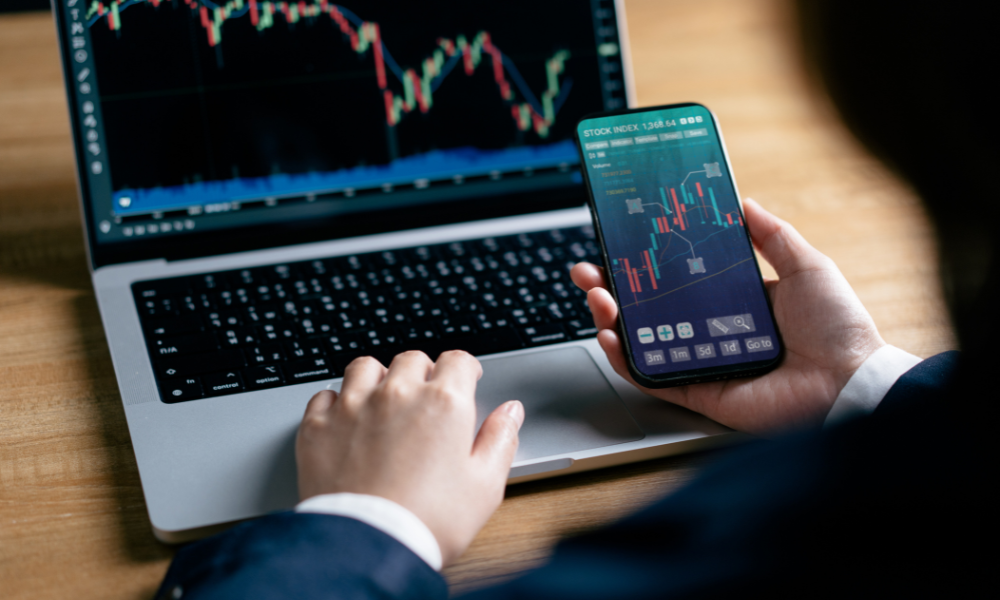

One of the worst days for US stocks since 2022 looks like a buying opportunity for the retail traders who have been among the market’s biggest bulls in recent years.
Small investors piled into many of their favorite assets, including Nvidia Corp. and the exchange-traded fund Vanguard S&P 500 ETF, as they bet that the market’s latest tumble will provide another contrarian opportunity for long-term gains, according to data tracking the users of Fidelity Investments’ brokerage.
Amazon.com Inc., Apple Inc., Tesla Inc., Meta Platforms Inc., and Microsoft Corp. were some of the most actively-traded individual companies among Fidelity users, with these stocks seeing two to eight times more buy orders than sell orders.
“Even if it keeps going lower, buy more to lower your cost average,” said Pedro Correia, a 30-year-old freelance software developer who said he has been reading financial books as he builds his own retirement portfolio. He bought shares of Amazon, Google and ASML Holding NV this week. “Ten years from now it’ll be higher, so the cheaper it gets the happier I am, because I can buy more.”
The buy-the-dip mentality has long reigned supreme among individual investors who lean into the notion that markets will inevitably go higher in the long term. During the market selloff in the early days of the Covid pandemic, the retail crowd was one of the only investor groups that was buying as others sold and many ended up benefiting from that decision.
This line of thinking faced another test on Thursday when losses accelerated around the globe after President Donald Trump escalated a trade war beyond what Wall Street had anticipated. Many professional investors are preparing for a significant slowdown in economic growth.
The S&P 500 Index tumbled more than 4% and the tech-heavy Nasdaq 100 dropped by 5%, wiping out some $3 trillion of total market value at one point. Companies like Apple, Nike Inc. and others dependent on oversees production were particularly hard hit.
Cries to rally and take advantage of the selloff reverberated across trader chatrooms like Stocktwits and a range of investing forums on Reddit. On X, users were commenting about the stock market being on sale and bragged about picking up “cheap” shares of Amazon and Apple.
Amid the flurry of buying, the high proportion of investors snapping up ETFs that track the S&P 500 and the Nasdaq 100 suggests that investors were looking to buy a broader basket of companies, rather than just technology giants, which have recently been among the worst performers.
“I’m adding — maybe in a couple years my future self will thank me,” said Kian Saidi, a 28-year-old Californian who says he became a full-time day trader in 2021. He is buying ETFs that track indexes including the S&P 500 and small-cap stocks.
“Historically the market generally goes higher. I don’t have an end goal of retiring in the next five months so it’s an opportunity to put money to work for the long run,” he said.
Still, the dip buying came despite nine-straight weeks of pessimistic sentiment among individual investors more broadly. The closely watched bull-bear spread from the weekly survey done by the American Association of Individual Investors, has held firmly negative since early February with a reading of negative 40 from Thursday. This survey, which looks beyond the day traders who have been so dominant in recent years, suggests that the majority of individual investors have a bearish view on equities over the next six months.

While industry statistics pointing to a succession crisis can cause alarm, advisor-owners should be free to consider a middle path between staying solo and catching the surging wave of M&A.

New joint research by T. Rowe Price, MIT, and Stanford University finds more diverse asset allocations among older participants.

With its asset pipeline bursting past $13 billion, Farther is looking to build more momentum with three new managing directors.

A Department of Labor proposal to scrap a regulatory provision under ERISA could create uncertainty for fiduciaries, the trade association argues.

"We continue to feel confident about our ability to capture 90%," LPL CEO Rich Steinmeier told analysts during the firm's 2nd quarter earnings call.
Orion's Tom Wilson on delivering coordinated, high-touch service in a world where returns alone no longer set you apart.
Barely a decade old, registered index-linked annuities have quickly surged in popularity, thanks to their unique blend of protection and growth potential—an appealing option for investors looking to chart a steadier course through today's choppy market waters, says Myles Lambert, Brighthouse Financial.
